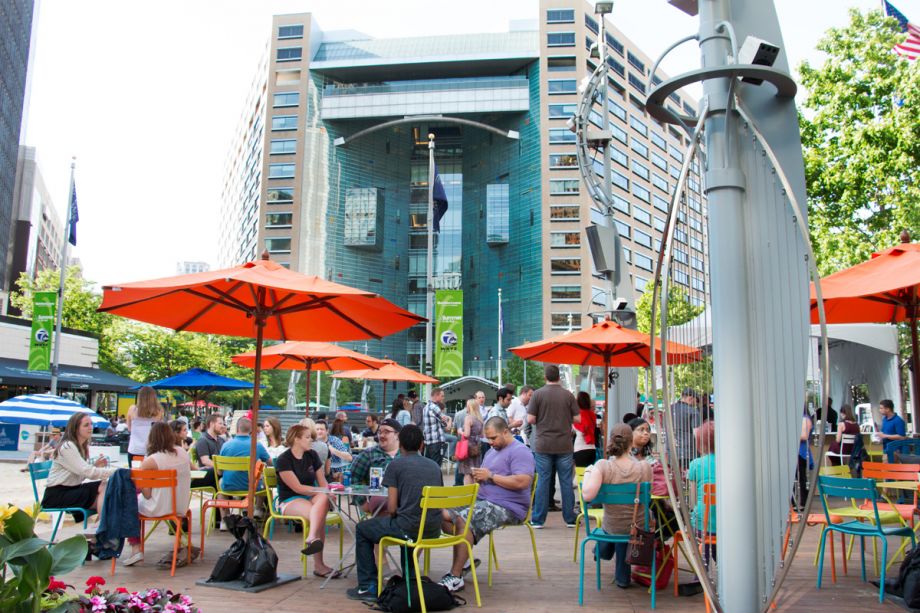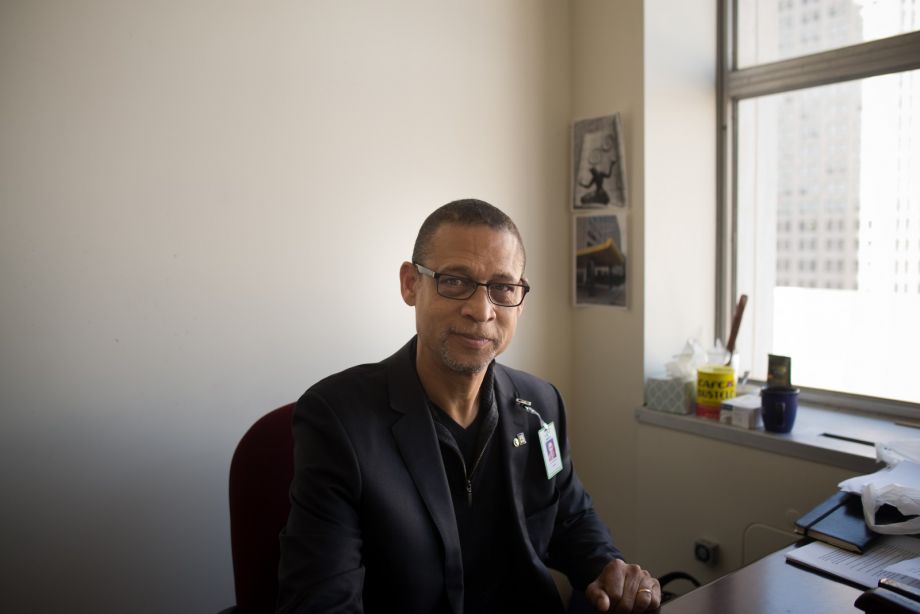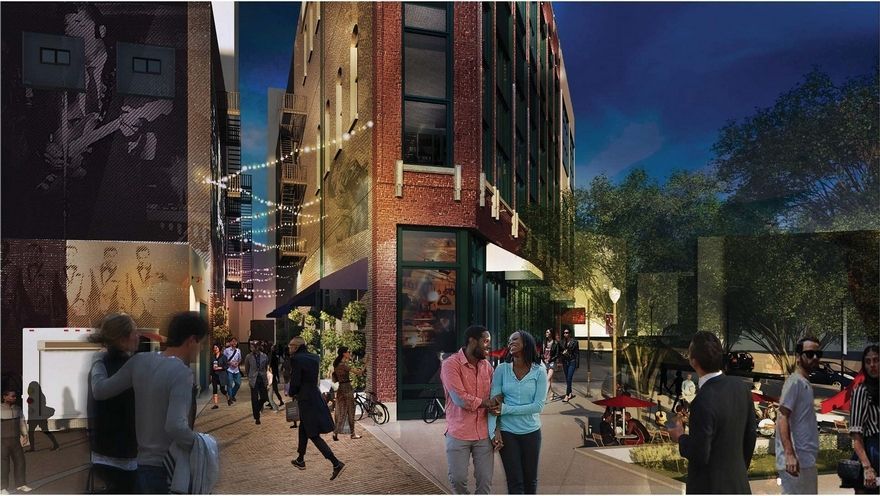Are You A Vanguard? Applications Now Open
Maurice Cox
This is your first of three free stories this month. Become a free or sustaining member to read unlimited articles, webinars and ebooks.
Become A MemberAt this point, the refrain of downtown Detroit’s resurgence is more embedded in the public consciousness than even the catchiest Motown tune. You know how this ditty goes: The hard-luck town with a barren central business district finds its hero in the form of Dan Gilbert, the Quicken Loans-Cleveland Cavaliers billionaire who saw opportunity in the vacancies, and turned dowdy office buildings into playgrounds for 20-something college grads who can’t afford Manhattan, so they settle Midwest.
That’s what Motown Records founder Berry Gordy would call the A-side, the popular song that shoots to the top of the charts. The B-side, however, isn’t the tune we love. Beyond downtown, pristine enclaves sit side-by-side with ugly, crumbling blocks, and municipal and community entities don’t have millions to spend to keep blight from spreading, nor all the incentives — whether a private security force, a manmade beach or kitschy neon-painted oversized tufted chairs — to keep people to stick around in the hopes that things will get better, eventually. That means for every bright-eyed wunderkind who settles into a renovated apartment, there’s a family of four crossing into suburbia and taking their dollars with them.
Not that anyone could blame them. Luxurious senior-citizen homes in previously all-white suburbs are increasingly filling with black retirees. School districts outside the city have been flooded with kids whose parents had no other options when their neighborhood schools closed. Upwardly mobile young couples stabilize their income and head to northern suburbs — but, unlike the generation before them that settled into inner-ring suburbs like Southfield or Oak Park, they’re headed even further north.
Detroit is losing more residents than it’s gaining, and not just because of turmoil in the city’s neighborhoods. Despite the energy downtown, it feels worlds away from onlookers in every neighborhood. The rebranded downtown, whether in media, advertising, development opportunity or access, feels overwhelmingly white in this city that’s more than 70 percent black. It feels white, despite the fact that a recent diversity index produced by Midtown Detroit Inc. shows that Midtown is home to a number of minority-owned businesses and attracts a significant amount of shoppers of color. But that disconnect between the feeling and the facts is part of the problem: When you look at who’s getting attention and who’s being marketed to, one can understand why a black Detroiter might have some misgivings.

People sit in a plaza outside the Quicken Loans headquarters in downtown Detroit. (Credit: Quicken Loans)
None of this is news to Detroit Mayor Mike Duggan, elected in 2013 as the first white mayor since the early 1970s, and so, he decided to do something about it. In 2015, the former county prosecutor lured the renowned African-American architect Maurice Cox to head up his planning department. Cox , who came to Detroit from New Orleans, where he served as Associate Dean for Community Engagement and Director of the Tulane City Center at the School of Architecture, has practiced in New York City and Florence, Italy, and served a term as the mayor of Charlottesville, Virginia, as well as the city’s planning director.
Few planning departments are headed by architects. Even fewer are headed by African-Americans. Cox can check both boxes.
“My first challenge was going to the planning office and bringing the other allied disciplines into the planning department,” Cox says. “I made the mayor of the city ask me, ‘what was it going to take to build the best planning department in the country?’ I assured him I could do it, but I would need the full complement of design professionals to pull this off.”
The city of Detroit, a population of roughly 700,000, had only six professional planning employees in its planning department, Cox says. Compare that with a rapidly redeveloping city like Washington, D.C., which has a slightly smaller population but employs about 60 in its planning department.
Cox sought out city planners, urban designers, landscape architects and historic preservationists, with key emphasis on the latter two, as Detroit has a surplus of vacant land — about 40 percent of vacant lots in the city are owned by Detroit — and historic buildings, vacant or otherwise.
But perhaps learning a lesson from D.C. and similar metros with sizable black populations, Cox has assembled a planning team that, per his observation, may well be the most diverse in any major metropolis: Of the roughly 25 employees in the city’s planning and development office, more than half of Cox’s most recent hires are people of color, women or both. This was intentional.
“Detroit is the largest majority African-American city in the country,” he says. “The promise of being able to bring back and revitalize an American city that has the profile of Detroit is really a singular opportunity, and so I had to make sure that the people that I hired looked like Detroit, could empathize with what Detroiters have been through, and really felt that they were coming here to drive the residents to drive the revitalizations of their neighborhoods.”
When Cox began brainstorming names for his Motor City dream team, one name kept coming to him: R. Steven Lewis. Old friends and colleagues, Lewis and Cox met as young architects in New York City in the 1970s, a time when black firms were beginning to win major contracts and make their mark in cities. One of those firms was Lewis-Turner Partnership, started by Lewis’ father, also an architect. Cox, then a student at the Cooper Union School of Architecture, was interning at the firm, while Lewis worked summers there. In the ensuing decades, Lewis started his own firm in Los Angeles, RAW International, worked for Parsons Corp. and did a stint with the federal government as well as one as a Loeb Fellow at Harvard University before serving as president of National Organization of Minority Architects in 2010. While at Harvard, he studied race and the profession of architecture and at NOMA, pushed for the creation of new programs to strengthen the pipeline for designers or color. All of that made Lewis an ideal person to be tapped for Cox’s mission.

R. Steven Lewis joined the Detroit planning department in early 2016.
“Steve allows us to expand the orbit of designers of color who might be a part of bringing back Detroit, as well as his commitment to equity which underlies everything that we are attempting to do here,” Cox says.
The longtime Angeleno, however, took some coaxing.
“It was a roller coaster, emotionally,” Lewis says on his first visit to the city. “I saw to the left, the University District neighborhood that had these beautiful, block after block, lovely homes that were just so manicured and well cared for and a bunch of black folks coming in and out of them.
“And I look to the right, and I see blocks and blocks of green, of just nothing and an occasional single structure,” he says. “The vastness of it was just gave me pause. What can you do? What can you really do?”
But Cox had plenty of ideas and wasn’t shy about sharing them. A longtime Trekkie — Lewis remembers watching the series during his days at Syracuse University School of Architecture — he conceded that “resistance is futile.” Finally, he packed his bags. He came first, his wife later and his daughter, a 32-year-old artist, soon after. They all live in Lafayette Park — fitting for an architect, as much of the neighborhood was conceived with the guiding hand of legendary German architect Ludwig Mies van der Rohe.
“(Cox) figured that mostly millennials with no families and few large responsibilities would be the likely candidates he would attract,” Lewis says about Cox’s goal to bring new energy to the department. “What he found, quite to his pleasure and amazement, was numerous mature professionals who saw the opportunity to be part of something historic in a black city poised for redevelopment but with a citizenry on the verge of being further disenfranchised in the face of rampant redevelopment.
“You now look at the complexion of the department and its leadership and you see gender diversity, racial diversity, but a clear dominance of African-Americans,” he adds. “All of us as a group including leadership and staff are fairly like-minded in our agreement in this experiment, which is how do you wrangle the ugly g-word — gentrification — into some order that allows or creates lanes for as many diverse citizens to participate as possible,” he says. “As bad as gentrification is perceived, in some communities it is, in fact, the economic engine that fuels development.”
Lewis says that he returned to government because he saw that the only way to ensure development leads to equitable outcomes is to be part of the process. In Detroit, the window of opportunity is still open. Much as other residents like to snark at the all the new restaurants that follow the paint-by-numbers layout of reclaimed wood, metal stools and white subway tile, gentrification hasn’t led to the displacement of people of color seen in cities such as D.C., which saw its black population dip below 50 percent for the first time in about 50 years in 2011. But the warning signs are there. In one downtown senior-citizen high-rise, its residents were notoriously evicted so their units could be refurbished into luxury apartments marketed in a much-derided video featuring overenthusiastic, mostly white millennials. And as high-end development swells downtown and in Midtown, residents in adjacent neighborhoods like Core City and North End can sway in two directions: Excited for the future, or worried about being the next to be forced out.
“How do you wrangle the ugly g-word — gentrification — into some order that allows or creates lanes for as many diverse citizens to participate as possible?”
Now the city’s planning department must make sure all Detroiters are included in this current revival — and note, this is the umpteenth revival for Detroit, a city whose populace has learned to live with broken promises.
“They finally have a sense that there’s a payback coming back,” says Cox. “They have stuck in with this city and now it’s time for some attention to be paid to those who are still here.”
The city of Detroit mandates that all new residential development must be 20 percent affordable. But, Lewis says, “I want to be careful when I talk to my white counterparts in organizations like Bedrock [Real Estate Services] and others, to caution them to not default, when they talk about affordability and low-income, to black folks.”
More frequently these days, but certainly not a stranger to the practice as a black professional, Lewis says he has to code-switch between the two Detroits: The white folks in the boardrooms who hold the purse strings, and the black folks outside the ivory tower. “You can see it in the body language,” Lewis says about white developer types. “They haven’t shared our experience, they don’t understand.”
The city’s planning department and its employees have become the bridge between the two, having to put more pressure on firms like Bedrock Real Estate Services — a division of Gilbert’s empire — to not only be inclusionary, but to be considerate.
“If Dan Gilbert brings thousands of Quicken employees, few of whom look like us as far as I’m concerned, they are the economic engine that is fueling what is going on here,” Lewis says.
But, “don’t overlook the large number of black middle-class and upper-class individuals that we have in the city who should be targeted as a market to participate in all of the new development, ownership and residency in all areas of the city that are experiencing this development pressure,” he adds.

A man bikes through the Jefferson-Chalmers neighborhood.
Detroit at its peak was the nation’s capital of black middle-class home ownership, a mentality that still persists despite many homeowners becoming renters after the 2009 housing crash. In recent years, the city of Detroit has embarked on several programs to convert renters to homeowners, including a mortgage program backed by foundation funding, and another program that offers of a select number of rehabbed homes to qualified buyers.
After decades in L.A., Lewis sees untapped opportunity in neighborhoods where many black families still have deep roots.
“There is tremendous economic power in the black community,” he says, pointing to retired NBA player Magic Johnson’s millions of dollars in investments in Southern California. “We have money in the black community that floods out.”
In his new hometown, the money tends to flood out into the suburbs. If black folks aren’t shopping there, they’re moving there. Cox and Lewis want to be part of the charge of keeping the money — and their earners — in the city.
“We need to be around each other for cultural reasons,” Lewis says. “Black folks have had to swim in two streams seemingly the whole time we’ve been here. We know how to do that. We still have different kinds of conversations when we’re among different kind of people — code-switching. And I think most white folks don’t really understand that … because it’s their world and we’re just living in it. There’s still a joy in the banter and communication that occurs between us that happens at the neighborhood level.”
But the days of fantasizing that all of these families will come back with a mortgage and a swing set for the backyard are over. Cox and Lewis are blunt about the need to accept that Detroit’s future will look different than its past.
“As architects and designers, we believe that the greatness that defines Detroit is from an architectural standpoint,” Lewis says. “But we’re not going to be building single-family neighborhoods like that anymore.”
“You can’t keep telling folks who have lived in neighborhoods that have lost population that folks are coming back,” Cox says. “Instead is there a way to regenerate those neighborhoods just for the people that are there?”
The architect uses the term productive land reuse to describe his vision of neighborhoods with a mix of small businesses, farms and orchards and greenways.
“One pilot that we are playing with going into a quarter square mile of a neighborhood, and go in and get rid that of all blight and all the buildings that are not salvageable,” Cox says. “Then we go in and renovate — with historic preservation in mind — all of the houses that are left. So you’ve got 100 homes and take the tens of acres that are vacant and come up with a design plan for every single acre in the neighborhood.”
This vision will take hundreds of millions of dollars and many years to realize. But just as difficult as the development, is the job of convincing longtime Detroiters to not only buy into the new map, but help draw it.
“It’s my impression that Detroiters have been waiting an awfully long time to be engaged in a forward looking conversation about the future of their neighborhoods,” Cox says.
It wasn’t, after all, that long ago that former Detroit Mayor Dave Bing made international news with suggestions that the city could benefit from a “right-sizing” that would reduce city services in sparsely populated parts of the city and encourage residents to move closer to the city downtown core. Not unlike the equally contentious post-Katrina imaginings of New Orleans, the planned retreat would have meant reducing public investment in largely black areas that had already suffered through redlining and other harmful public policies. For many black Detroiters, the idea hit like a slap in the face.
Duggan’s administration is careful to avoid suggesting that any one part of the city won’t be inhabited in the future. Catch any of the city’s Land Bank officials outside the office at a neighborhood watering hole, and you’ll hear the repeated mantra of keeping existing neighbors while adding in new ones. More people need to stay than leave. Yet the vision being shopped around by Cox’s team contain the same underlying principles of compact design and many of the same elements, including urban agriculture and higher-density residential development along busier commercial corridors, with housing above retail. “That will bring populations back that will serve the tax base,” Lewis says.
Touchy is the word Lewis uses to describe how Detroiters feel about the remake of their neighborhoods.
“Our average layperson, they’re going back to Donna Reed and Andy Griffith, and what the idea or mental image of what home is,” he says. “We are of the mind that we are in the 21st century and our city should reflect that, and that collides often with the aesthetic preference of many laypeople want.”
And Duggan’s being the first white mayor in more than 40 years doesn’t make the work of rebuilding public trust any simpler.
That means folks like Cox and Lewis are more out front than ever.
“My goal is for my staff to meet people where they are,” Cox says. “We should promise only what we can deliver and plan for implementation. So when we go into neighborhoods, we go in not to plan for planning’s sake, but to plan for their priorities and to plan what we think we can deliver. We start demonstrating change in the very beginning of the planning process.”
Lewis puts it more plainly: “If we come from them who are them, and we can’t get this done, it ain’t gon’ get done,” Lewis says.
In June, five development teams — four of which were led by black business owners — announced a collective $52.4 million investment in Harmonie Park, a sliver of downtown Detroit populated with a handful of minority-owned businesses. Plans range from a cigar bar and jazz club to boutique hotels and office space. The area will be rebranded as Paradise Valley Cultural and Entertainment District, a throwback to the black-populated Paradise Valley entertainment district — Detroit’s Bourbon Street — that was destroyed via urban renewal in the 1950s.
“Part of this is creating early successes where black folks are present in development deals in a number of places where people wouldn’t ordinarily see them,” Lewis says.

A rendering of the renovated Harmonie Park in downtown Detroit (Credit: Detroit Economic Development Corp.)
And then there are the smaller displays. In another neighborhood along the city’s riverfront, requests for purchases were opened to developers, but Cox held interviews in public libraries for neighbors to hear what they had planned before granting the RFPs. “Nothing like that had ever happened before,” Lewis says.
“If you have a plan for action, a plan for engagement, you rebuild trust that the city will deliver on the promise that it makes to residents,” Cox says. “And we have that willingness to deliver, willingness to engage, to listen and let them drive the planning decisions of their neighborhood.”
Cox witnessed this when he and the city recruited 300 volunteers from the University of Detroit Mercy on the city’s west side to paint bike lanes and board up vacant homes in the surrounding neighborhood. “For me, engagement is doing stuff with residents and demonstrating the power and transformation that design can produce.”
Bike lanes alone cannot save a neighborhood. But, Cox says, “it gets [residents] used to change. You don’t have wait 12 months for change. But when the change happens, they’ve seen a little bit of it — it gives them a sense that it’s happening now.”
In October, Lewis and Cox presented at a conference on how their identities as black professionals play a role in the work they do in Detroit. It touched on disinvestment in the city, and what’s needed to ensure the city’s majority is part of the way forward. Including difficult conversations.
“We were going to call it ‘The Big Bet,’” Lewis says. “But now, it’s called ‘The Big Payback.’” he laughs.
This article is part of a Next City series focused on community-engaged design made possible with the support of the Surdna Foundation.
Aaron Foley is a Detroit-based writer and editor, and author of the guidebook “How to Live in Detroit Without Being a Jackass.”

Alan Chin was born and raised in New York City’s Chinatown. Since 1996, he has worked in China, the former Yugoslavia, Afghanistan, Iraq and Central Asia. Domestically, Alan has followed the historic trail of the Civil Rights movement, documented the aftermath of Hurricane Katrina and covered the 2008 presidential campaign. He is a contributing photographer to Newsweek, the New York Times and BagNews, an editor and photographer at Newsmotion and a photographer at Facing Change: Documenting America (FCDA). Alan’s work is in the collection of the Museum of Modern Art.

20th Anniversary Solutions of the Year magazine